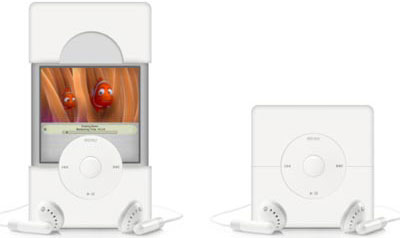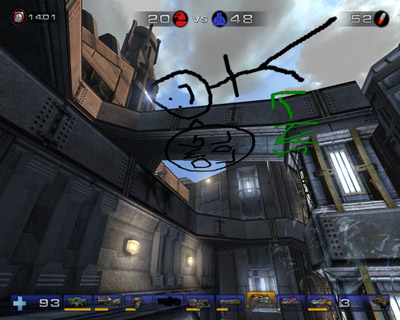Security Awareness
A bunch of links from a blog I discovered recently.
« April 2005 | Main | June 2005 »
A bunch of links from a blog I discovered recently.
Bernard Rappaz has a fake image of a video iPod in one of his recent posts. I don’t know where he got it from but he is shrewd enough to throttle the rumour before anyone can think he’s trying to make them believe it.

I find this image interesting, though, because it’s so easy and fun to deconstruct it. Let’s have a go at it, step by step:
Storage – Considering that video takes a tad more storage space than audio, it would be foolish to pretend that a portable video would use a micro hard disk drive similar to the one found in the iPod mini, that peaks at 6 GB. Even 10 GB would be ridiculously small. One can therefore assume that such a device would use a 1.8-inch drive like the regular iPods.
Size – A 1.8-inch hard drive is 1.8-inch wide. The full dimensions, in units meaningful to the readers of this blog, are 5 × 54 × 78.5 mm3. The device shown on the picture unfolds to reveal the display. Folded, it has a square footprint. An iPod with the same hard drive is 10 cm high by 6 cm wide and seeing one open makes it clear that it couldn’t be much shorter.
There are therefore exactly two ways our video device could contain a 1.8-inch drive. Either it’s 10 cm wide by 10 cm tall or it’s 6 cm tall by 6 cm wide and 10 cm thick. Now take out your iPod and imagine it either as wide as it’s tall or as thick as it’s wide. Would you carry that in your pocket?
Display – Unfolded, the device on the picture is shaped vertically, but the display is horizontal, with a 16:9 aspect ratio. Make it 8.5 by 4.8 cm2. This leaves just enough room on the 10 by 10 cm2 square to put the iPod’s 4 cm click wheel. There’s no point to the folded design then. Moreover, how silly does a vertical device with a horizontal display look?
If I were to make a fake video iPod, I would make it the size of a regular iPod, with a 4.4 by 8 cm2 display and the click wheel that unfolds on one side. Folded, it would look just like the iPod and be used as such, with the display rotated so you can hold the device vertically. Unfolded, it would be held horizontally, with a large display and a properly sized click wheel on either side.
Steven Frank is wondering whom to pass the musical baton to. Please, Pick me! Pick me! Me! Me!
I came across this the other day in Unreal Tournament 2004, on map DM-CBP2-Meitak:

I’m glad I took a screen shot because I’ve never been able to find it again.
Googling “OMG LOL Jay Meitak” return results about Community Bonus Pack 2, with the following description for Meitak:
DM-Meitak by Nick ‘neoduck’ Donaldson
As the cheers of the crowd echo in the stadium outside, you prepare yourself for the battle ahead. You hear a voice, distant but clear, ring though the arena. You look around, intent on finding the source. It cries out again… ‘OMG LOL’ … it’s only Jay.
Has anybody else seen this Easter egg? If so, drop me a note in the comments.
Giles Turnbull in Introducing Mac Worm X:
Imagine a mail message arrives from a friend, with an attached file. "I found this great Dashboard widget!" it says, "Try it out!"
User double-clicks. A widget is installed.
He goes on about how the widget could be evil and harm your system and files.
First of all, double-clicking a widget doesn't install it anywhere, it just runs it. Closing the widget makes it disappear from Dashboard entirely. But that's not the point.
Let's alter the situation a bit:
Imagine a mail message arrives from a friend, with an attached file. "I found this great application!" it says, "Try it out!"
I don't double click it because my friends send me URLs, not applications. The same is true for widgets. Moreover, an application has the same, if not more, devastating potential as a Dashboard widget, and it's been possible to e-mail applications since the Internet was invented.
So why all the fuss?
I am pinging this entry about Wordpress and Movable Type to test if trackback works.
A friend of mine told me that his website, Modulotech System Integration, which has been operational since almost three years, never got indexed by Google. That’s strange.